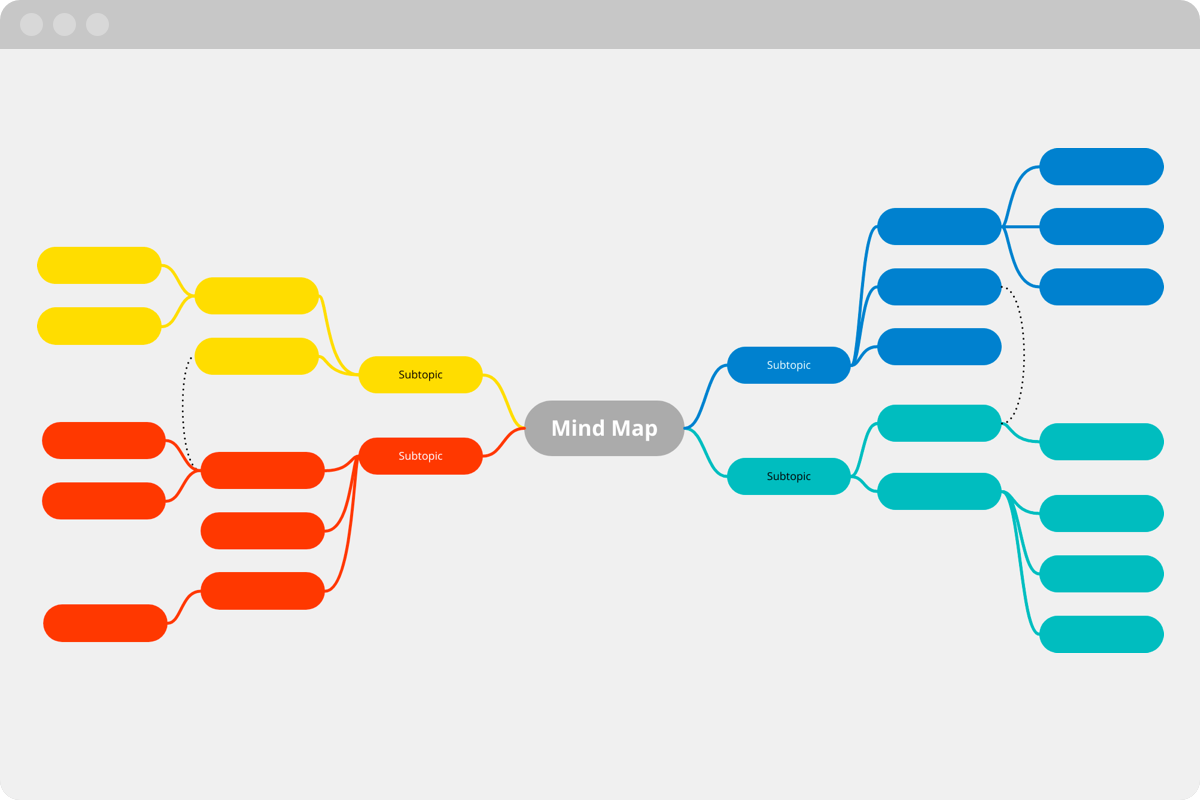Use the mind map template to generate a large volume of ideas
If you'd like to create your own Mind Map template, using a digital template will help you get started. While you can certainly mind map on a blank piece of paper, using an online template provides the benefit of limitless space for your ideas.

Mind Maps are a great way to organize information, connect related ideas, and help capture the flow of ideas during a brainstorming session. Visualizing ideas and concepts on a Mind Map template allows you to showcase your thoughts in an organic, yet easy to follow manner by linking connected ideas. Much like the way the mind works! Mind Map templates are also a great place to note down your brilliant ideas before you forget them!
Using a Mind Map Template
If you’d like to create your own Mind Map template, using a digital template will help you get started. While you can certainly mind map on a blank piece of paper, using an online template provides the benefit of limitless space for your ideas. It also gives you the flexibility to add digital images, sketches or graphs straight into the map. Moving online also allows you to continually update your Mind Map and easily share or invite other team members to join it.

The Mind Map template is powered by our latest release: Line Connectors. Perfect for anyone with a penchant for beautiful, clear diagrams. The line connector feature will also be a great asset for helping you create beautiful Flow Charts. Need more help with remote Brainstorming meetings? Read our article about successful virtual collaboration in 2025.
How To Create A Mind Map
Mind maps are great tools for brainstorming sessions, taking notes, or working through complex problems. They help you see the bigger picture and identify previously unseen relationships or correlations. If you’re interested in alternative brainstorming methods, we’ve rounded up a list of 15 brainstorming techniques and templates you can use collaboratively with your team.
So whether you’re working on ideas for a new product launch, writing study notes, or even preparing for a career change, the first step to creating a Mind Map is to decide on your key topic. Once you have this you will be able to design the idea around it. If you are collaborating, you can invite team members to join your digital Mind Map board to ensure you can tap into everyone’s ideas.
To get started ask a clear question based on what you want to accomplish during your session and start jotting down ideas from there. Remember the old ad age “no idea is a bad idea” and be sure to note down all ideas, even if they seem ludicrous at the time. You never know when you may change your mind and regret throwing it out.
Try to restrict each branch to just one or two words. If an idea is complex, or hard to define in one word, an image might be useful instead.
Once you’ve extrapolated enough ideas you can wrap up the session. Then you can start sorting through ideas and select any standout ideas that deserve to be followed up on.
Every Mind Map will look different according to how your brainstorming session is carried out. However, here are five key things you should remember when completing a Mind Map:
- The core idea is placed in the center of the map. As this is the main focus, you could add an image or make it quite large.
- Parent branches are the next subgroup that branch out from the core idea. Don’t worry about the amount of subgroup ideas you have, the more the better. These should be given a new color.
- Continue extending by adding any child branches that relate to the parent ideas in another color.
- Join linked topics using the new curve line connector feature to help produce innovative maps that are visually pleasing.
- Whenever possible, add a visual to a branch or sub-branch. Using examples and sketches not only helps visualize the ideas, but it also helps with comprehension.
Discover visual collaboration
Collaborate seamlessly across teams and timezones with Conceptboard’s collaborative digital whiteboard

